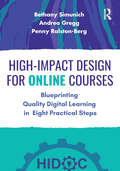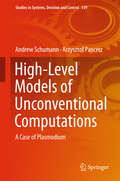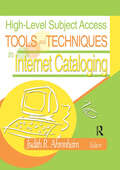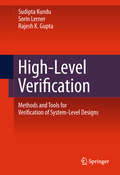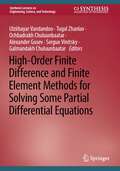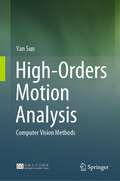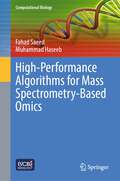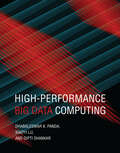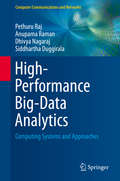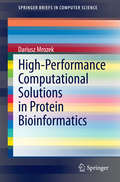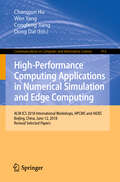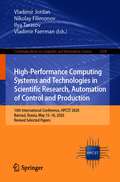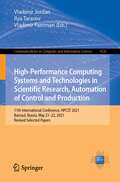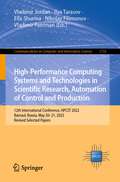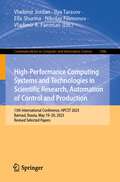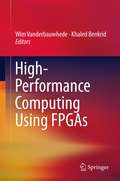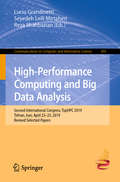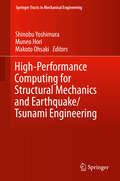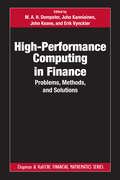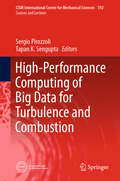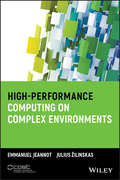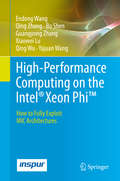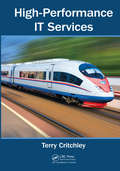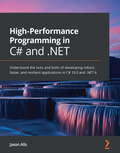- Table View
- List View
High-Impact Design for Online Courses: Blueprinting Quality Digital Learning in Eight Practical Steps
by Andrea Gregg Bethany Simunich Penny Ralston-BergHigh-Impact Design for Online Courses introduces higher education professionals to an eight-step course design model that leverages the unique considerations of online and hybrid modalities at each stage in the process. Though relevant to and informed by instructional designers and educational technologists, this book is specifically geared toward faculty who lack the administrative and technical supports they need to thrive in the new normal. Each chapter includes step-by-step guidance on learner analysis, course structure, appropriate activities and assessments, continuous improvement, and other key elements of a successful digital course. Teachers across disciplines and levels of experience will come away newly inspired and motivated with fresh insights into planning and drafting, practical tips for pedagogy and design, opportunities for self-reflection and course revision, and implications for learner-centered delivery.
High-Impact eportfolio Practice: A Catalyst for Student, Faculty and Institutional Learning
by Bret Eynon Laura M. GambinoAt a moment when over half of US colleges are employing ePortfolios, the time is ripe to develop their full potential to advance integrative learning and broad institutional change. The authors outline how to deploy the ePortfolio as a high-impact practice and describe widely-applicable models of effective ePortfolio pedagogy and implementation that demonstrably improve student learning across multiple settings. Drawing on the campus ePortfolio projects developed by a constellation of institutions that participated in the Connect to Learning network, Eynon and Gambino present a wealth of data and revealing case studies. Their broad-based evidence demonstrates that, implemented with a purposeful framework, ePortfolios correlate strongly with increased retention and graduation rates, broadened student engagement in deep learning processes, and advanced faculty and institutional learning. The core of the book presents a comprehensive research-based framework, along with practical examples and strategies for implementation, and identifies the key considerations that need to be addressed in the areas of Pedagogy, Professional Development, Outcomes Assessment, Technology and Scaling Up. The authors identify how the ePortfolio experience enhances other high-impact practices (HIPs) by creating unique opportunities for connection and synthesis across courses, semesters and co-curricular experiences. Using ePortfolio to integrate learning across multiple HIPs enables students reflect and construct a cohesive signature learning experience. This is an invaluable resource for classroom faculty and educational leaders interested in transformative education for 21st century learners.
High-Level Models of Unconventional Computations: A Case Of Plasmodium (Studies in Systems, Decision and Control #159)
by Krzysztof Pancerz Andrew SchumannThis book shows that the plasmodium of Physarum polycephalum can be considered a natural labelled transition system, and based on this, it proposes high-level programming models for controlling the plasmodium behaviour. The presented programming is a form of pure behaviourism: the authors consider the possibility of simulating all basic stimulus–reaction relations. As plasmodium is a good experimental medium for behaviouristic models, the book applies the programming tools for modelling plasmodia as unconventional computers in different behavioural sciences based on studying the stimulus–reaction relations. The authors examine these relations within the framework of a bio-inspired game theory on plasmodia they have developed i.e. within an experimental game theory, where, on the one hand, all basic definitions are verified in experiments with Physarum polycephalum and Badhamia utricularis and, on the other hand, all basic algorithms are implemented in the object-oriented language for simulations of plasmodia. The results allow the authors to propose that the plasmodium can be a model for concurrent games and context-based games.
High-Level Subject Access Tools and Techniques in Internet Cataloging
by Judith AhronheimIs your library's portal as efficient as it could be? High-Level Subject Access Tools and Techniques explores the potential and early development of high-level subject access. It examines Web tools and traditionally maintained library structures that facilitate the automated relation of resources to high-level subject categories based on the descriptive metadata that already exists in traditional library records. It includes a research study of high-level subject browse structures, as well as hands-on reports of actual projects and development activities and an examination of the environment in which demand for high-level subject access arises. From the editor: As the World Wide Web and graphic user interfaces developed in the 90s, libraries began to build gateways for their online resources. These gateways allowed library users to employ the browse, point, and click approach to resource discovery that they had come to expect from online tools. Most of these interfaces amounted to little more than hand-constructed lists of links. Today, many libraries offer access to users through a set list of broad topics, sometimes called a high-level browse display. Methods for populating these subject categories remain crude and their maintenance requires considerable resources. As a result, libraries have begun to look at ways of applying traditional techniques associated with cataloging to these new interfaces. Several goals are involved in these developments. Many hope to reuse data from library catalogs and thus limit maintenance burdens. Others seek to apply a more standard set of tools and principles to the construction of portals to allow greater cooperation among institutions that want to interoperate with each other. This pathbreaking book examines vital issues in high-level subject access, including: subject trees and their relationship to the structure inherent in Dewey Classification emerging patterns in the development of browsing services, including a hierarchy of subjects that is not based in classification, a map that relates data from catalog records to the subject hierarchy, and tools for extracting data from a catalog and storing it in a separate database to produce a more flexible display task-based (as opposed to materials-based) subject lists the social issues that are associated with choosing categoriesbased on the nature and activity of an institution's library users the political issues involved in selecting disciplines or topics for a browsing service And presents fascinating case studies of: Columbia University's efforts to build an automatically generated browsable display based on Library of Congress Classification as it occurs in catalog records the High-Level Thesaurus Project (HILT), in which a group of libraries, archives, and museums attempted to find a common method for high-level subject access via portal
High-Level Verification
by Sorin Lerner Sudipta Kundu Rajesh K. GuptaGiven the growing size and heterogeneity of Systems on Chip (SOC), the design process from initial specification to chip fabrication has become increasingly complex. This growing complexity provides incentive for designers to use high-level languages such as C, SystemC, and SystemVerilog for system-level design. While a major goal of these high-level languages is to enable verification at a higher level of abstraction, allowing early exploration of system-level designs, the focus so far for validation purposes has been on traditional testing techniques such as random testing and scenario-based testing. This book focuses on high-level verification, presenting a design methodology that relies upon advances in synthesis techniques as well as on incremental refinement of the design process. These refinements can be done manually or through elaboration tools. This book discusses verification of specific properties in designs written using high-level languages, as well as checking that the refined implementations are equivalent to their high-level specifications. The novelty of each of these techniques is that they use a combination of formal techniques to do scalable verification of system designs completely automatically. The verification techniques presented in this book include methods for verifying properties of high-level designs and methods for verifying that the translation from high-level design to a low-level Register Transfer Language (RTL) design preserves semantics. Used together, these techniques guarantee that properties verified in the high-level design are preserved through the translation to low-level RTL.
High-Order Finite Difference and Finite Element Methods for Solving Some Partial Differential Equations (Synthesis Lectures on Engineering, Science, and Technology)
by Ulziibayar Vandandoo Tugal Zhanlav Ochbadrakh Chuluunbaatar Alexander Gusev Sergue Vinitsky Galmandakh ChuluunbaatarThe monograph is devoted to the construction of the high-order finite difference and finite element methods for numerical solving multidimensional boundary-value problems (BVPs) for different partial differential equations, in particular, linear Helmholtz and wave equations, nonlinear Burgers’ equations, and elliptic (Schrödinger) equation. Despite of a long history especially in development of the theoretical background of these methods there are open questions in their constructive implementation in numerical solving the multidimensional BVPs having additional requirement on physical parameters or desirable properties of its approximate solutions. Over the last two decades many papers on this topics have been published, in which new constructive approaches to numerically solving the multidimensional BVPs were proposed, and its highly desirable to systematically collect these results. This motivate us to write thus monograph based on our research results obtained in collaboration with the co-authors. Since the topic is importance we believe that this book will be useful to readers, graduate students and researchers interested in the field of computational physics, applied mathematics, numerical analysis and applied sciences
High-Orders Motion Analysis: Computer Vision Methods
by Yan SunThis book shows how different types of motion can be disambiguated into their components in a richer way than that currently possible in computer vision. Previous research of motion analysis has generally not yet considered the basic nature of higher orders of motion such as acceleration. Hence, this book introduces an approximation of the acceleration field using established optical flow techniques. Further, acceleration is decomposed into radial and tangential based on geometry and propagated as a general motion descriptor; this book shows the capability for differentiating different types of motion both on synthesized data and real image sequences. Beyond acceleration, the higher orders of motion flow and their continuant parts are investigated for further revealing the chaotic motion fields. Naturally, it is possible to extend this notion further: to detect higher orders of image motion. In this respect, this book shows how jerk and snap can be obtained from image sequences. The derived results on test images and heel strike detection in gait analysis illustrate the ability of higher-order motion, which provide the basis for the following research and applications in the future. We hope that the publication of this book will bring a new perspective to researchers and graduate students in the field of video analysis in computer vision.
High-Performance Algorithms for Mass Spectrometry-Based Omics (Computational Biology)
by Fahad Saeed Muhammad HaseebTo date, processing of high-throughput Mass Spectrometry (MS) data is accomplished using serial algorithms. Developing new methods to process MS data is an active area of research but there is no single strategy that focuses on scalability of MS based methods. Mass spectrometry is a diverse and versatile technology for high-throughput functional characterization of proteins, small molecules and metabolites in complex biological mixtures. In the recent years the technology has rapidly evolved and is now capable of generating increasingly large (multiple tera-bytes per experiment) and complex (multiple species/microbiome/high-dimensional) data sets. This rapid advance in MS instrumentation must be matched by equally fast and rapid evolution of scalable methods developed for analysis of these complex data sets. Ideally, the new methods should leverage the rich heterogeneous computational resources available in a ubiquitous fashion in the form of multicore, manycore, CPU-GPU, CPU-FPGA, and IntelPhi architectures. The absence of these high-performance computing algorithms now hinders scientific advancements for mass spectrometry research. In this book we illustrate the need for high-performance computing algorithms for MS based proteomics, and proteogenomics and showcase our progress in developing these high-performance algorithms.
High-Performance Big Data Computing (Scientific and Engineering Computation)
by Dhabaleswar K. Panda Xiaoyi Lu Dipti ShankarAn in-depth overview of an emerging field that brings together high-performance computing, big data processing, and deep lLearning. Over the last decade, the exponential explosion of data known as big data has changed the way we understand and harness the power of data. The emerging field of high-performance big data computing, which brings together high-performance computing (HPC), big data processing, and deep learning, aims to meet the challenges posed by large-scale data processing. This book offers an in-depth overview of high-performance big data computing and the associated technical issues, approaches, and solutions. The book covers basic concepts and necessary background knowledge, including data processing frameworks, storage systems, and hardware capabilities; offers a detailed discussion of technical issues in accelerating big data computing in terms of computation, communication, memory and storage, codesign, workload characterization and benchmarking, and system deployment and management; and surveys benchmarks and workloads for evaluating big data middleware systems. It presents a detailed discussion of big data computing systems and applications with high-performance networking, computing, and storage technologies, including state-of-the-art designs for data processing and storage systems. Finally, the book considers some advanced research topics in high-performance big data computing, including designing high-performance deep learning over big data (DLoBD) stacks and HPC cloud technologies.
High-Performance Big-Data Analytics
by Pethuru Raj Anupama Raman Dhivya Nagaraj Siddhartha DuggiralaThis book presents a detailed review of high-performance computing infrastructures for next-generation big data and fast data analytics. Features: includes case studies and learning activities throughout the book and self-study exercises in every chapter; presents detailed case studies on social media analytics for intelligent businesses and on big data analytics (BDA) in the healthcare sector; describes the network infrastructure requirements for effective transfer of big data, and the storage infrastructure requirements of applications which generate big data; examines real-time analytics solutions; introduces in-database processing and in-memory analytics techniques for data mining; discusses the use of mainframes for handling real-time big data and the latest types of data management systems for BDA; provides information on the use of cluster, grid and cloud computing systems for BDA; reviews the peer-to-peer techniques and tools and the common information visualization techniques, used in BDA.
High-Performance Computational Solutions in Protein Bioinformatics
by Dariusz MrozekRecent developments in computer science enable algorithms previously perceived as too time-consuming to now be efficiently used for applications in bioinformatics and life sciences. This work focuses on proteins and their structures, protein structure similarity searching at main representation levels and various techniques that can be used to accelerate similarity searches. Divided into four parts, the first part provides a formal model of 3D protein structures for functional genomics, comparative bioinformatics and molecular modeling. The second part focuses on the use of multithreading for efficient approximate searching on protein secondary structures. The third and fourth parts concentrate on finding 3D protein structure similarities with the support of GPUs and cloud computing. Parts three and four both describe the acceleration of different methods. The text will be of interest to researchers and software developers working in the field of structural bioinformatics and biomedical databases.
High-Performance Computing Applications in Numerical Simulation and Edge Computing: ACM ICS 2018 International Workshops, HPCMS and HiDEC, Beijing, China, June 12, 2018, Revised Selected Papers (Communications in Computer and Information Science #913)
by Wen Yang Changjun Hu Congfeng Jiang Dong DaiThis book constitutes the referred proceedings of two workshops held at the 32nd ACM International Conference on Supercomputing, ACM ICS 2018, in Beijing, China, in June 2018. This volume presents the papers that have been accepted for the following workshops: Second International Workshop on High Performance Computing for Advanced Modeling and Simulation in Nuclear Energy and Environmental Science, HPCMS 2018, and First International Workshop on HPC Supported Data Analytics for Edge Computing, HiDEC 2018. The 20 full papers presented during HPCMS 2018 and HiDEC 2018 were carefully reviewed and selected from numerous submissions. The papers reflect such topics as computing methodologies; parallel algorithms; simulation types and techniques; machine learning.
High-Performance Computing Systems and Technologies in Scientific Research, Automation of Control and Production: 10th International Conference, HPCST 2020, Barnaul, Russia, May 15–16, 2020, Revised Selected Papers (Communications in Computer and Information Science #1304)
by Vladimir Jordan Nikolay Filimonov Ilya Tarasov Vladimir FaermanThis book constitutes selected revised and extended papers from the 10th International Conference on High-Performance Computing Systems and Technologies in Scientific Research, Automation of Control and Production, HPCST 2020, Barnaul, Russia, in May 2020. Due to the COVID-19 pancemic the conference was partly held in virtual mode. The 14 full papers presented in this volume were thoroughly reviewed and selected form 51 submissions. The papers are organized in topical sections on hardware for high-performance computing and its applications; information technologies and computer simulation of physical phenomena.
High-Performance Computing Systems and Technologies in Scientific Research, Automation of Control and Production: 11th International Conference, HPCST 2021, Barnaul, Russia, May 21–22, 2021, Revised Selected Papers (Communications in Computer and Information Science #1526)
by Vladimir Jordan Ilya Tarasov Vladimir FaermanThis book constitutes selected revised and extended papers from the 11th International Conference on High-Performance Computing Systems and Technologies in Scientific Research, Automation of Control and Production, HPCST 2021, Barnaul, Russia, in May 2021. The 32 full papers presented in this volume were thoroughly reviewed and selected form 98 submissions. The papers are organized in topical sections on Hardware for High-Performance Computing and Signal Processing; Information Technologies and Computer Simulation of Physical Phenomena; Computing Technologies in Discrete Mathematics and Decision Making; Information and Computing Technologies in Automation and Control Science; and Computing Technologies in Information Security Applications.
High-Performance Computing Systems and Technologies in Scientific Research, Automation of Control and Production: 12th International Conference, HPCST 2022, Barnaul, Russia, May 20–21, 2022, Revised Selected Papers (Communications in Computer and Information Science #1733)
by Vladimir Jordan Nikolay Filimonov Ilya Tarasov Vladimir Faerman Ella ShurinaThis book constitutes the refereed proceedings of the 12th International Conference on High-Performance Computing Systems and Technologies in Scientific Research, Automation of Control and Production, HPCST 2022, held in Barnaul, Russia, during May 20–21, 2022. The 23 full papers included in this book were carefully reviewed and selected from 116 submissions. They were organized in topical sections as follows: hardware for high-performance computing and signal processing; information technologies and computer simulation of physical phenomena; computing technologies in data analysis and decision making; and computing technologies in information security applications.
High-Performance Computing Systems and Technologies in Scientific Research, Automation of Control and Production: 13th International Conference, HPCST 2023, Barnaul, Russia, May 19–20, 2023, Revised Selected Papers (Communications in Computer and Information Science #1986)
by Vladimir Jordan Nikolay Filimonov Ilya Tarasov Ella Shurina Vladimir A. FaermanThis book constitutes the revised selected papers of the 13th International Conference on HPCST 2023, held in Barnaul, Russia, during May 19–20, 2023.The 21 full papers included in this book were carefully reviewed and selected from 81 submissions. The papers are organized in topical sections as follows: Hardware for High-Performance Computing and Signal Processing; Information Technologies and Computer Simulation of Physical Phenomena; Computing Technologies in Data Analysis and Decision Making; Information and Computing Technologies in Automation and Control Science; Computing Technologies in Information Security Applications.
High-Performance Computing Using FPGAs
by Khaled Benkrid Wim VanderbauwhedeHigh-Performance Computing using FPGA covers the area of high performance reconfigurable computing (HPRC). This book provides an overview of architectures, tools and applications for High-Performance Reconfigurable Computing (HPRC). FPGAs offer very high I/O bandwidth and fine-grained, custom and flexible parallelism and with the ever-increasing computational needs coupled with the frequency/power wall, the increasing maturity and capabilities of FPGAs, and the advent of multicore processors which has caused the acceptance of parallel computational models. The Part on architectures will introduce different FPGA-based HPC platforms: attached co-processor HPRC architectures such as the CHREC's Novo-G and EPCC's Maxwell systems; tightly coupled HRPC architectures, e.g. the Convey hybrid-core computer; reconfigurably networked HPRC architectures, e.g. the QPACE system, and standalone HPRC architectures such as EPFL's CONFETTI system. The Part on Tools will focus on high-level programming approaches for HPRC, with chapters on C-to-Gate tools (such as Impulse-C, AutoESL, Handel-C, MORA-C++); Graphical tools (MATLAB-Simulink, NI LabVIEW); Domain-specific languages, languages for heterogeneous computing(for example OpenCL, Microsoft's Kiwi and Alchemy projects). The part on Applications will present case from several application domains where HPRC has been used successfully, such as Bioinformatics and Computational Biology; Financial Computing; Stencil computations; Information retrieval; Lattice QCD; Astrophysics simulations; Weather and climate modeling.
High-Performance Computing and Big Data Analysis: Second International Congress, TopHPC 2019, Tehran, Iran, April 23–25, 2019, Revised Selected Papers (Communications in Computer and Information Science #891)
by Lucio Grandinetti Seyedeh Leili Mirtaheri Reza ShahbazianThis book constitutes revised and selected papers from the Second International Congress on High-Performance Computing and Big Data Analysis, TopHPC 2019, held in Tehran, Iran, in April 2019.The 37 full papers and 2 short papers presented in this volume were carefully reviewed and selected from a total of 103 submissions. The papers in the volume are organized acording to the following topical headings: deep learning; big data analytics; Internet of Things.- data mining, neural network and genetic algorithms; performance issuesand quantum computing.
High-Performance Computing for Structural Mechanics and Earthquake/Tsunami Engineering
by Makoto Ohsaki Shinobu Yoshimura Muneo HoriHuge earthquakes and tsunamis have caused serious damage to important structures such as civil infrastructure elements, buildings and power plants around the globe. To quantitatively evaluate such damage processes and to design effective prevention and mitigation measures, the latest high-performance computational mechanics technologies, which include telascale to petascale computers, can offer powerful tools. The phenomena covered in this book include seismic wave propagation in the crust and soil, seismic response of infrastructure elements such as tunnels considering soil-structure interactions, seismic response of high-rise buildings, seismic response of nuclear power plants, tsunami run-up over coastal towns and tsunami inundation considering fluid-structure interactions. The book provides all necessary information for addressing these phenomena, ranging from the fundamentals of high-performance computing for finite element methods, key algorithms of accurate dynamic structural analysis, fluid flows with free surfaces, and fluid-structure interactions, to practical applications with detailed simulation results. The book will offer essential insights for researchers and engineers working in the field of computational seismic/tsunami engineering.
High-Performance Computing in Finance: Problems, Methods, and Solutions (Chapman and Hall/CRC Financial Mathematics Series)
by M. A. H. Dempster, Juho Kanniainen, John Keane and Erik VynckierHigh-Performance Computing (HPC) delivers higher computational performance to solve problems in science, engineering and finance. There are various HPC resources available for different needs, ranging from cloud computing– that can be used without much expertise and expense – to more tailored hardware, such as Field-Programmable Gate Arrays (FPGAs) or D-Wave’s quantum computer systems. High-Performance Computing in Finance is the first book that provides a state-of-the-art introduction to HPC for finance, capturing both academically and practically relevant problems.
High-Performance Computing of Big Data for Turbulence and Combustion (CISM International Centre for Mechanical Sciences #592)
by Tapan K. Sengupta Sergio PirozzoliThis book provides state-of-art information on high-accuracy scientific computing and its future prospects, as applicable to the broad areas of fluid mechanics and combustion, and across all speed regimes. Beginning with the concepts of space-time discretization and dispersion relation in numerical computing, the foundations are laid for the efficient solution of the Navier-Stokes equations, with special reference to prominent approaches such as LES, DES and DNS. The basis of high-accuracy computing is rooted in the concept of stability, dispersion and phase errors, which require the comprehensive analysis of discrete computing by rigorously applying error dynamics. In this context, high-order finite-difference and finite-volume methods are presented. Naturally, the coverage also includes fundamental notions of high-performance computing and advanced concepts on parallel computing, including their implementation in prospective hexascale computers. Moreover, the book seeks to raise the bar beyond the pedagogical use of high-accuracy computing by addressing more complex physical scenarios, including turbulent combustion. Tools like proper orthogonal decomposition (POD), proper generalized decomposition (PGD), singular value decomposition (SVD), recursive POD, and high-order SVD in multi-parameter spaces are presented. Special attention is paid to bivariate and multivariate datasets in connection with various canonical flow and heat transfer cases. The book mainly addresses the needs of researchers and doctoral students in mechanical engineering, aerospace engineering, and all applied disciplines including applied mathematics, offering these readers a unique resource.
High-Performance Computing on Complex Environments
by Julius Zilinskas Emmanuel Jeannot* Covers cutting-edge research in HPC on complex environments, following an international collaboration of members of the ComplexHPC * Explains how to efficiently exploit heterogeneous and hierarchical architectures and distributed systems* Twenty-three chapters and over 100 illustrations cover domains such as numerical analysis, communication and storage, applications, GPUs and accelerators, and energy efficiency
High-Performance Computing on the Intel® Xeon PhiTM
by Bo Shen Qing Zhang Endong Wang Guangyong Zhang Xiaowei Lu Qing Wu Yajuan WangThe aim of this book is to explain to high-performance computing (HPC) developers how to utilize the Intel® Xeon Phi(tm) series products efficiently. To that end, it introduces some computing grammar, programming technology and optimization methods for using many-integrated-core (MIC) platforms and also offers tips and tricks for actual use, based on the authors' first-hand optimization experience. The material is organized in three sections. The first section, "Basics of MIC", introduces the fundamentals of MIC architecture and programming, including the specific Intel MIC programming environment. Next, the section on "Performance Optimization" explains general MIC optimization techniques, which are then illustrated step-by-step using the classical parallel programming example of matrix multiplication. Finally, "Project development" presents a set of practical and experience-driven methods for using parallel computing in application projects, including how to determine if a serial or parallel CPU program is suitable for MIC and how to transplant a program onto MIC. This book appeals to two main audiences: First, software developers for HPC applications - it will enable them to fully exploit the MIC architecture and thus achieve the extreme performance usually required in biological genetics, medical imaging, aerospace, meteorology and other areas of HPC. Second, students and researchers engaged in parallel and high-performance computing - it will guide them on how to push the limits of system performance for HPC applications.
High-Performance IT Services
by Terry CritchleyThis book on performance fundamentals covers UNIX, OpenVMS, Linux, Windows, and MVS. Most of the theory and systems design principles can be applied to other operating systems, as can some of the benchmarks. The book equips professionals with the ability to assess performance characteristics in unfamiliar environments. It is suitable for practitioners, especially those whose responsibilities include performance management, tuning, and capacity planning. IT managers with a technical outlook also benefit from the book as well as consultants and students in the world of systems for the first time in a professional capacity.
High-Performance Programming in C# and .NET: Understand the nuts and bolts of developing robust, faster, and resilient applications in C# 10.0 and .NET 6
by Jason AllsEnhance your applications' performance using best practices for benchmarking, application profiling, asynchronous programming, designing responsive UIs, gRPC communication, and distributed applicationsKey FeaturesMake the best use of performance enhancements in C# 10.0 and .NET 6Boost application performance by identifying hardware bottlenecks and common performance pitfallsGet to grips with best practices and techniques for improving the scalability of distributed systemsBook DescriptionWriting high-performance code while building an application is crucial, and over the years, Microsoft has focused on delivering various performance-related improvements within the .NET ecosystem. This book will help you understand the aspects involved in designing responsive, resilient, and high-performance applications with the new version of C# and .NET.You will start by understanding the foundation of high-performance code and the latest performance-related improvements in C# 10.0 and .NET 6. Next, you'll learn how to use tracing and diagnostics to track down performance issues and the cause of memory leaks. The chapters that follow then show you how to enhance the performance of your networked applications and various ways to improve directory tasks, file tasks, and more. Later, you'll go on to improve data querying performance and write responsive user interfaces. You'll also discover how you can use cloud providers such as Microsoft Azure to build scalable distributed solutions. Finally, you'll explore various ways to process code synchronously, asynchronously, and in parallel to reduce the time it takes to process a series of tasks.By the end of this C# programming book, you'll have the confidence you need to build highly resilient, high-performance applications that meet your customer's demands.What you will learnUse correct types and collections to enhance application performanceProfile, benchmark, and identify performance issues with the codebaseExplore how to best perform queries on LINQ to improve an application's performanceEffectively utilize a number of CPUs and cores through asynchronous programmingBuild responsive user interfaces with WinForms, WPF, MAUI, and WinUIBenchmark ADO.NET, Entity Framework Core, and Dapper for data accessImplement CQRS and event sourcing and build and deploy microservicesWho this book is forThis book is for software engineers, professional software developers, performance engineers, and application profilers looking to improve the speed of their code or take their skills to the next level to gain a competitive advantage. You should be a proficient C# programmer who can already put the language to good use and is also comfortable using Microsoft Visual Studio 2022.
